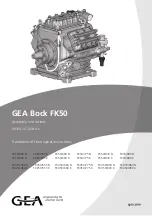
Page 69 of
85
4.8.6 Disassembly – 1
st
/ 2
nd
Stage Piston
1. Decompress and degas the compressor.
2. Remove
1
st
stage inlet pipe.
3. Remove
1
st
stage discharge pipe.
4. Unscrew
1
st
stage cylinder head retaining screws / nuts.
5. Remove cylinder head.
6. Loosen
1
st
stage piston “power”nut locking screws (refer section 4.8 item
#8).
7. Remove power nut.
8. Remove
1
st
/ 2
nd
stage piston.
9. Remove piston spacer.
10. Unscrew the six 1
st
/ 2
nd
stage cylinder retaining nuts.
11. Remove 1
st
/ 2
nd
stage cylinder.
4.8.7 Reassembly
1
st
/ 2
nd
Stage Cylinder
1. Check
1
st
/ 2
nd
stage cylinder bore for wear and score marks.
2. Replace cylinder oring.
3. Reinstate
cylinder.
4. Tighten cylinder retaining nuts to correct torque.
5. Lightly oil cylinder bore.
6. Ensure
that
1
st
and 2
nd
stage piston rings have correct end gaps and side
clearances (refer piston ring clearance table in section 3.4.2)
7. Fit
1
st
and 2
nd
stage piston rings to piston.
8. Ensure that the piston rings are well oiled on the piston.
9. Fit piston to piston rod.
10. To slide piston into cylinder, 2
nd
stage piston rings will need to be
compressed into their ring grooves. The 2
nd
stage rings will need to be
accessed through 2
nd
stage valve ports. Use 2 x flat ended pieces of mild
steel rod (1 through the inlet valve port and 1 through the discharge valve
port) to compress the piston rings into their ring grooves. With the bottom
piston ring compressed into its ring groove, gently push the piston into the
cylinder. Repeat the process with each piston ring, 1 ring at a time.
11. 1
st
stage piston rings will need to be compressed simultaneously with the 2
nd
stage rings as the piston is slid into the cylinder.
Intermech Ltd. BBR-6015-2 Compressor Service Manual
















































